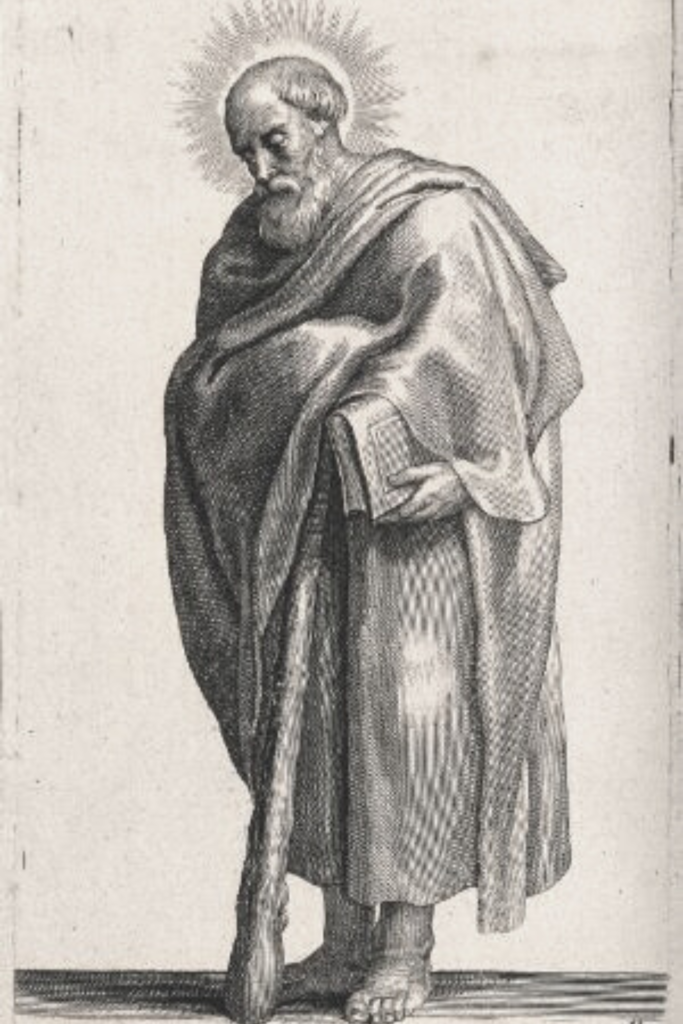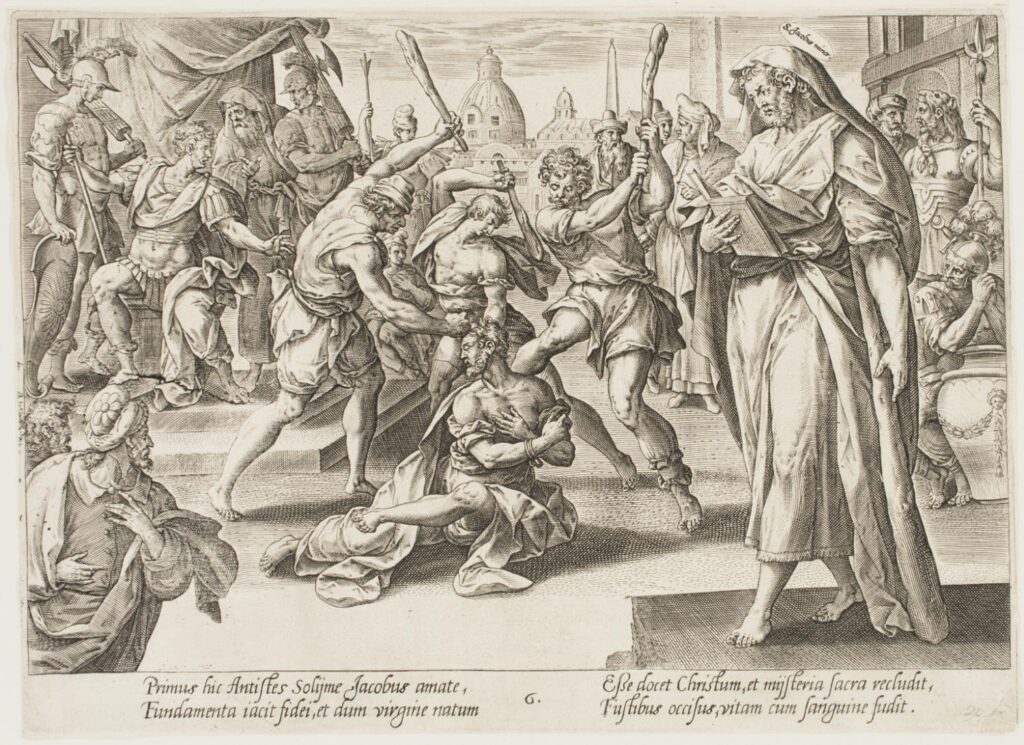The Brother of God

The brother of our Lord, St. James of Jerusalem, also called “the Just,” is commemorated on October 23rd. An apostle, author, martyr, and the first bishop of Jerusalem, St. James is an important character in the New Testament. But fleshing out exactly who this saint was and wasn’t can be a bit confusing. Indeed, even to this day there are differing opinions on James’s identity. Similar to our run-down of “who’s who” in other posts about the Myrrhbearers, Mary Magdalene, and Bartholomew, let’s first start with what is broadly agreed upon about St. James.
James was a close relation to Jesus. He is called the brother of Jesus, or commonly, ὁ Ἀδελφόθεος literally “the brother of God.” Matthew makes note of this when Jesus returns to his hometown and they don’t receive him. The people ask, “And are not his brothers James and Joseph and Simon and Judas?” (Matt. 13:55).
There is some disagreement concerning whether James was or was not one of the twelve disciples or an apostle. Nevertheless, Christians of the early church including Paul respected James as an eyewitness of the resurrection (1 Corinthians 15:7). Moreover, we get an interesting account in John’s Gospel that states that “not even his brothers believed in him.”
This unbelief of the disciples is exemplified in other stories of John, as well. When Jesus went up to the Feast of Booths the brothers sought a sign from him, but Jesus explained that his time had not yet come. The unbelief that John and Mary exhibit at the wedding in Cana is a motif throughout the book of John—even those closest to Jesus do not yet understand what his ministry is about. At least they don’t until his passion and resurrection when he prays “Father, the hour has come; glorify your Son that the Son may glorify you (John 17:1).
After Pentecost, James appears to remain in Jerusalem. During this time, he is established as a pillar and bishop over the church. We hear of him again in Acts when he presided over the Council of Jerusalem. Paul and Barnabas bring a question to the apostles and elders there, and James provides a response. He states that the Gentiles should not be burdened with the whole law of Moses, specifically circumcision, but ought first to abstain from idolatry, sexual immorality, and certain kinds of meat (bloody and that which was strangled). He also affirms to them that most meats that were formerly unclean are now permissible to meat.
This council is the last we hear from the New Testament account of James. Of course, we what seem to be his own words that he wrote in the Epistle of James. Early Christian historians date James’s death at A.D. 62. Eusebius chronicles the earliest days of the Church, including tidbits about James, and even provides an account of his martyrdom, which was reportedly a brutal, drawn-out event: first he was taken to the pinnacle of the temple, and after proclaiming Christ there, he was thrown down. However, he survived the fall, which is when his persecutors began stoning him, which he also reportedly endured. Finally, his glory was complete after a blow with a bat, accomplishing his martyrdom for his Lord.
Brief History
As mentioned above, the various Jameses in the New Testament are confusing at times. There are two or possibly three Jameses. The first is James the Greater, who is the son of Zebedee and one of the twelve disciples. His commemoration falls on July 25th, and there is little debate about who he was. The second James is the son of Alphaeus and was also one of the twelve. His feast falls together with Philip on May 1st. Then, we also have a James who is commemorated on October 23rd, the day we are discussing here. This date is considered by many to honor the James who is the brother of Jesus, bishop of Jerusalem, and author of the epistle bearing his name.

The real point of confusion comes with last two: James the son of Alpheus and James the brother of our Lord. Many question whether they are one and the same or two separate people. A few of our favorite sources, including Loehe’s Martyrologium and Jacobus de Voragine’s Golden Legend, seem to indicate that there was no third James but that James of Jerusalem and the son of Alphaeus were one and same. Additionally, de Voragine gives the explanation that Alphaeus is also the same as Clopas, the husband of the Virgin Mary’s sister (also named Mary), making James a cousin of Jesus, which is one possible way “brother” could be understood to the Jews of that time.
Nevertheless, our Lutheran Church—Missouri Synod as well as the Episcopal Church commemorate James of Jerusalem separately on October 23rd. In the Eastern churches, October 23rd is but one of three feast days dedicated to this James. The Roman Catholic Church don’t recognize a third James and instead observes only the May 1st feast of Philip and James, which the LCMS commemorates, as well.
The epistle of James is a book of the New Testament, even if Martin Luther notoriously had his misgivings about it (at times). The five-chapter-long epistle is ascribed to a man who humbly identifies himself as “a servant of God” and writes to the twelve tribes in the dispersion. Among Lutherans, the book is perhaps best known for James’ discourse on living faith—that “faith by itself, if it does not have works, is dead” (James 2:17). This is a point that our confessions confirm and discuss in length in the Apology of the Augsburg Confession (Article IV: Of Love and the Fulfilling of the Law, paragraphs 123-132), which would be a suitable reading for St. James’ Day, which falls only one week before the observance of the Reformation on October 31st!

Collect
Heavenly Father, shepherd of Your people, You raised up James the Just, brother of our Lord, to lead and guide Your Church. Grant that we may follow his example of prayer and reconciliation and be strengthened by the witness of his death; through Jesus Christ, Your Son, our Lord, who lives and reigns with You and the Holy Spirit, one God, now and forever.
Lessons
Resources
Issues, Etc. interview with the Rev. David Petersen on St. James of Jerusalem
Propers found in Daily Divine Service Book: A Lutheran Daily Missal, edited by the Rev. Heath Curtis
References:
1. Weedon, William. Celebrating the Saints. Concordia Publishing House. 2016.
2. Eusebius of Caesarea. Church History. ca. 341 AD.
3. Voragine, Jacobus de. The Golden Legend: Reading on the Saints. Vol. 2. Translated by William Granger Ryan. Princeton Press. 1993.
Images:
1. Saint James the Less, Peter Paul Rubens, Belgium ca. 1600.
2. Saint James the Just, artist unknown.
3. The Martyrdom of St. James the Younger, by the Circle of Hendrick Goltzius, Dutch, c. 1578.
Some links might be affiliate links which means we may receive a small commission at no extra cost to you. As an Amazon Associate we earn from qualifying purchases.




Earliest reference to his martyrdom is in Josephus, 20:9:1